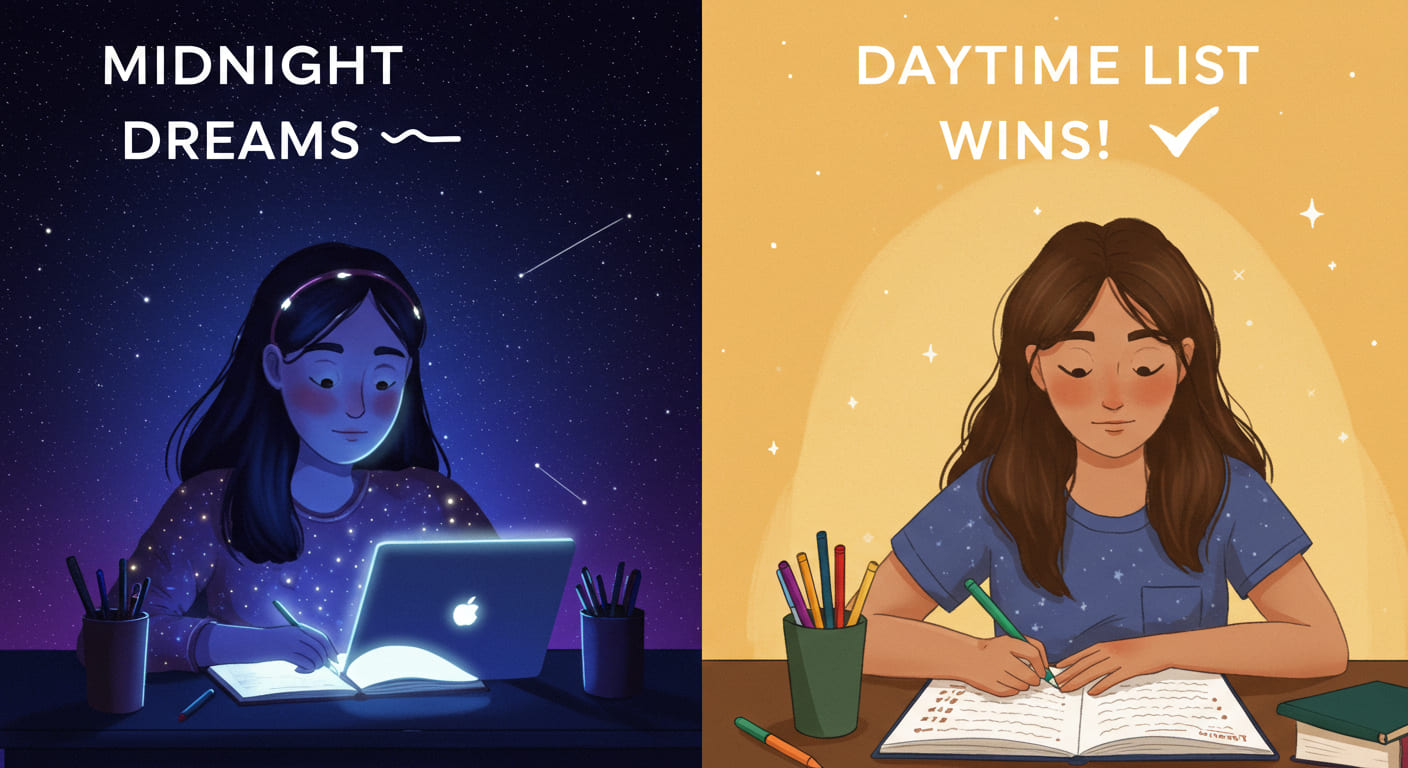You inhale deeply, remove the day’s burden by relaxing to your Favorite sitcom, and casually doze off. And then BAM just like that, at 12:00 a.m. you’re wide awake and set with astounding ideas: “I have an exam at noon, but I’ll absolutely nudge an ‘A’ out of that. A term project is due next week, but I’ll begin that during my afternoon classes. I’ll exercise daily, and get out of my comfort zone. This is my metamorphosis semester.” Sounds familiar? Well guess what: It’s perfectly common for students with lots of tasks to complete, feel that way at midnight.
This article will centre itself around the reasons why figuring out why what happens at midnight feels so transformative and potent is key provides answers to so many questions. That “pre-midday delusion,” as I call it, is what fuels every overworked individual to chase so much tasks desperately like a lion chases prey, only to be unsatisfied when they wake up in the morning. So, tell me lazybones, ready to dive into some action? Go ahead check this article out and share it with your friends who might be curious on turning their under-oxygenated nocturnal brainstorming to actionable strategies for day-time achievements.
The Midnight Mindset: Why It Feels Different
Isn’t it notable how your brain tends to feel unburdened at night? As noted in the transcript, midnight has a way of mysteriously waking things up inside of us. The clamour of the day, which includes the deadlines, group chats, and the myriads of emails from professors, becomes quiet. Research suggests that stressors like cortisol dip at night which leads to relaxation, allowing spacious thoughts. It is during these hours that students entertain possibilities such as beginning a side hustle or studying, which actually do not seem plausible during the daytime. This section teaches us that ‘the midnight hour’ is when the mind unfenced where imagination knows no boundaries. Therefore, this window of moonlit hour should be seized as it is naturally built for creativeness.
The Morning Fade: Why Dreams Slip Away
The bold version of you that existed at midnight is guiltily of feeling alien come morning. Your brain goes into survival mode the minute your cortisol levels spike. As a result, focus gravitates towards spells of toxicity, lists of looming tasks, and the ever-present need to assess risk factors. Students often experience these worries in form of late submissions, second-guessing, or even procrastination (wondering whether they’re overestimating their plans). This decline, like many things in life, is not a shortcoming- it’s a biological reality. Understanding this biologically-propelled baseline allows for effective preparation in anticipation of daylight’s demands while simultaneously keeping the daring dreams alive.
One Small Step: The Power of Starting Small
The transcript captures the essence of transformation perfectly by describing how change begins with “one small step.” This could mean setting a timer to review lecture notes for 15 minutes rather than planning an exhaustive study session. Small steps help cultivate momentum. Strive to Set one tiny goal daily such as reading a chapter or organizing your desk and see how these tiny actions accumulate over time. The result: feeling more in control as you move closer to your goals.
The Magic of Progress Over Perfection
“People who actually make results and get gains make moves” is also of note in the transcript. In this case, it can be applied as “showing up” for students means doing it for their goals, even if imperfectly. If a study session was missed, try again the next day without throwing the plan out the window. Consistency breeds midnight fantasies into a life one day to become a reality. For instance: “A student commits to 20 minutes daily of focused work and by the end of the semester has unwittingly built a studying habit stronger than what any all-nighter could cultivate” and work toward steady progress that bolsters feelings of empowerment.
Carrying the Spark into Daylight
The transcript reads that the “true magic” lies in what you carry into the daylight. How do you achieve this? Build a connection between your midnight thoughts and your everyday life. Before sleeping, set one specific goal, for example, “Email my professor about that extension.” Upon waking up, tend to this task immediately. Executing this small habit integrates your daytime self with the self that feels inspired, allowing for the possibility of wishing to appear less like an existence. What do you get out of this? Your capacity to follow through will begin to improve.
Key Takeaways
- Midnight’s Power: Your brain is more creative at night when stress hormones drop, making it a great time to dream big.
- Morning Reality: The daytime fade is biological, not a failure—expect it and plan to counter it.
- Start Small: One tiny action, like studying for 15 minutes, can kickstart meaningful change.
- Stay Consistent: Imperfect but regular effort builds habits that align with your midnight goals.
- Bridge the Gap: Write down one goal at night and act on it in the morning to make dreams reality.
Conclusion: Make Your Midnight Sparks Count
Your midnight ideas don’t have to stay in the dark—they can light up your student life. Not every plan will stick, and that’s okay. The beauty of these late-night moments is their flexibility: you can try, fail, and try again. Whether it’s tackling one assignment, starting a new habit, or dreaming up a future career, the key is to take that first small step. So tonight, when the clock strikes midnight and inspiration hits, jot down one idea. Tomorrow, give it a shot. You’ve got this—your best self is waiting to shine.
